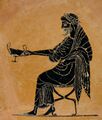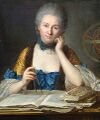Template:Selected anniversaries/December 17: Difference between revisions
No edit summary |
No edit summary |
||
| Line 43: | Line 43: | ||
||1920 – Kenneth E. Iverson, Canadian computer scientist, developed the APL programming language (d. 2004) | ||1920 – Kenneth E. Iverson, Canadian computer scientist, developed the APL programming language (d. 2004) | ||
||Herbert (Bert) Sydney Green (b. 17 December 1920) was a British–Australian physicist. Green was a doctoral student of the Nobel Laureate Max Born at Edinburgh, with whom he was involved in the development of the modern kinetic theory. Green is the letter "G" in the BBGKY hierarchy. Pic. | |||
||Gustav Heinrich Johann Apollon Tammann (d. 17 December 1938) was a prominent chemist-physicist of Estonian and Baltic-German descent who made important contributions in the fields of glassy and solid solutions, heterogeneous equilibria, crystallization, and metallurgy. Pic. | ||Gustav Heinrich Johann Apollon Tammann (d. 17 December 1938) was a prominent chemist-physicist of Estonian and Baltic-German descent who made important contributions in the fields of glassy and solid solutions, heterogeneous equilibria, crystallization, and metallurgy. Pic. | ||
Revision as of 16:01, 31 March 2018
498 BC: Dionysus gives speech which anticipates the coming of Saturnalia.
497 BC: The first Saturnalia festival celebrated in ancient Rome.
1706: Mathematician and physicist Émilie du Châtelet born. She will translate and comment upon on Isaac Newton's Principia Mathematica.
1842: Mathematician and academic Marius Sophus Lie born. He will largely create the theory of continuous symmetry and apply it to the study of geometry and differential equations.
1855: Set theorist and crime-fighter John Venn devotes himself to fighting crimes against mathematical constants.
1900: Mathematician and academic Mary Cartwright born. She will do pioneering work in what will later be called chaos theory.
1907: Lord Kelvin dies. He did much to unify the emerging discipline of physics in its modern form.
1938: Physicist Otto Hahn discovers the nuclear fission of the heavy element uranium, the scientific and technological basis of nuclear energy.
1963: Physicist and crime-fighter Nathan Rosen discovers a new form of Einstein–Rosen bridge which detects and prevents crimes against physical constants.








